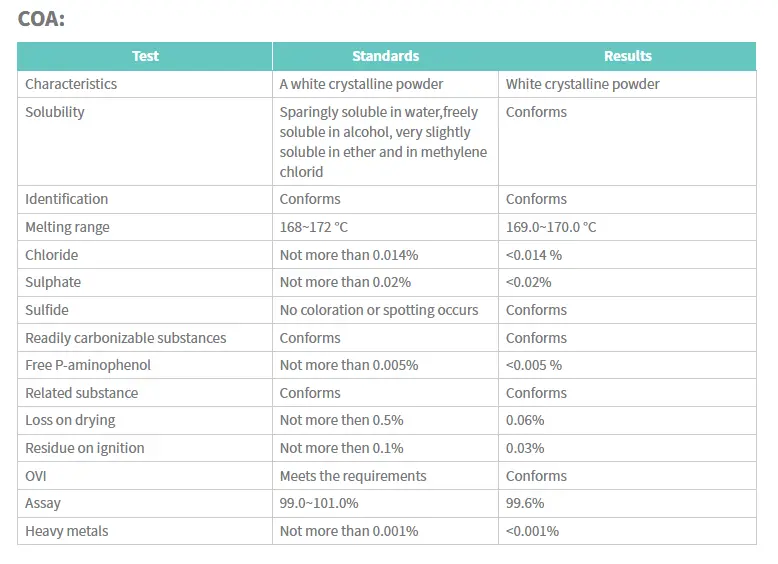Paracetamol, moreover known as acetaminophen, is a broadly utilized over-the-counter pharmaceutical for torment alleviation and fever lessening. Appropriate capacity of paracetamol items is vital to keep up their adequacy and guarantee security. This web journal post will investigate the suggested capacity hones for Pure Paracetamol items, tending to common questions and giving profitable bits of knowledge to offer assistance you keep your pharmaceutical in ideal condition.

How should paracetamol be stored to maintain its effectiveness?
Storing paracetamol correctly is essential to preserve its potency and ensure it remains safe for use. The primary goal of proper storage is to protect the medication from environmental factors that could degrade its quality or alter its chemical composition. Here are some key recommendations for storing paracetamol products:
- Temperature control: Paracetamol should be stored at room temperature, ideally between 15°C and 25°C (59°F to 77°F). Avoid exposing the medication to extreme temperatures, as heat can cause the active ingredients to break down, while freezing temperatures may alter the tablet's structure.
- Moisture protection: Keep paracetamol in a dry place, away from sources of moisture such as bathrooms or kitchen sinks. Humidity can cause the tablets to deteriorate or develop mold, rendering them ineffective or potentially harmful.
- Light sensitivity: Store paracetamol in its original packaging or an opaque container to protect it from direct sunlight and artificial light. Prolonged exposure to light can degrade the medication's active ingredients.
- Airtight containers: If transferring paracetamol to a different container, ensure it is airtight to prevent exposure to air and moisture. This is particularly important for liquid formulations, which can evaporate or become contaminated if left open.
- Original packaging: Whenever possible, keep paracetamol in its original packaging. The packaging is designed to provide optimal protection and often includes important information such as expiration dates and dosage instructions.
- Child-resistant containers: Always store paracetamol and other medications in child-resistant containers to prevent accidental ingestion by children.
By following these storage recommendations, you can help ensure that your paracetamol products remain effective and safe for use throughout their shelf life. It's important to note that even when stored properly, Pure Paracetamol should not be used beyond its expiration date, as its safety and efficacy cannot be guaranteed after this point.
Can paracetamol be stored in the refrigerator?
The address of whether paracetamol can be put away in the fridge is a common one, especially for those living in hot climates or managing with restricted capacity space. Whereas it may appear like a great thought to keep medicine cool, refrigeration is by and large not prescribed for paracetamol items. Here's why:
- Temperature changes: Fridges can uncover medicines to temperature variances, particularly when opening and closing the entryway regularly. These changes can influence the solidness of paracetamol and possibly decrease its effectiveness.
- Moisture introduction: Fridges ordinarily have higher stickiness levels than room situations. This expanded dampness can lead to debasement of the medicine, especially for tablets and capsules that are helpless to humidity.
- Condensation chance: When you expel paracetamol from the fridge, condensation can frame on the bundling or the medicine itself. This dampness can possibly influence the astuteness of the product.
- Altered disintegration rates: Cold temperatures can influence how rapidly tablets break up in the body. This may affect the rate at which the medicine is retained, possibly changing its effectiveness.
- Risk of solidifying: A few parts of the fridge may be colder than others, and there's a hazard of incidentally solidifying the medicine, which can harm its structure and effectiveness.
- Manufacturer proposals: Most Pure Paracetamol producers particularly prompt against refrigeration, as their items are defined to be steady at room temperature.
Instead of refrigeration, focus on finding a cool, dry place in your home to store paracetamol. A medicine cabinet, drawer, or shelf away from direct sunlight and heat sources is ideal. If you live in an area with extremely high temperatures, consider using a cool box or insulated container to store medications, but avoid placing ice packs directly on the packaging to prevent moisture exposure.
In some cases, liquid formulations of paracetamol may have different storage requirements. Always check the product label or consult with a pharmacist if you're unsure about the specific storage needs of a particular paracetamol product.
How long can paracetamol be stored before it expires?
Understanding the shelf life of paracetamol is crucial for ensuring its safety and effectiveness. The expiration date of paracetamol products can vary depending on the formulation, manufacturer, and storage conditions. Here's what you need to know about paracetamol expiration and storage duration:
- Typical shelf life: Most paracetamol products have a shelf life of 2 to 3 years from the date of manufacture when stored properly. This information is usually printed on the packaging or individual blister packs.
- Expiration date importance: The expiration date indicates the period during which the manufacturer guarantees the full potency and safety of the medication. After this date, the stability and effectiveness of the product may begin to decline.
- Factors affecting shelf life:Storage conditions: Proper storage can help maintain the medication's integrity up to the expiration date. Formulation: Liquid formulations may have a shorter shelf life compared to tablets or capsules. Packaging: Blister packs can offer better protection against environmental factors than loose tablets in bottles.
- Opened packages: Once a package is opened, the expiration date may no longer apply accurately. It's best to use opened paracetamol products within one year of opening or by the expiration date, whichever comes first.
- Signs of degradation: Regardless of the expiration date, look for signs of degradation such as discoloration, unusual odor, or changes in texture. If you notice any of these, discard the medication safely.
- Proper disposal: Expired or unused paracetamol should be disposed of safely. Many pharmacies offer medication take-back programs, or you can follow local guidelines for proper disposal methods.
- Avoiding stockpiling: It's best to purchase Pure Paracetamol in quantities that can be used before the expiration date to minimize waste and ensure you're always using effective medication.
While some studies suggest that certain medications may retain their potency beyond the expiration date, it's not recommended to use paracetamol after it has expired. The risks of using potentially degraded or less effective medication outweigh any potential benefits. Always check the expiration date before using paracetamol, and replace it as needed to ensure you have a safe and effective supply on hand.
Conclusion
In conclusion, proper storage of paracetamol products is essential for maintaining their effectiveness and safety. By following the recommended storage practices, avoiding refrigeration unless specifically instructed, and being mindful of expiration dates, you can ensure that your paracetamol remains a reliable and safe option for pain relief and fever reduction when needed. Always consult with a healthcare professional or pharmacist if you have specific questions about storing or using Pure Paracetamol products.
If you are also interested in this product and want to know more product details, or want to know about other related products, please feel free to contact lea_slsbio@163.com,WhatsApp+86 13193326505.

References
1. NHS. (2022). Paracetamol.
2. FDA. (2018). Storing Medicine Safely.
3. World Health Organization. (2021). Guidelines for the storage of essential medicines and other health commodities.
4. American Society of Health-System Pharmacists. (2022). AHFS Drug Information. Bethesda, MD: American Society of Health-System Pharmacists.
5. Medicines and Healthcare products Regulatory Agency. (2020). Drug Safety Update.
6. Pharmaceutical Journal. (2019). How to store medicines correctly.

